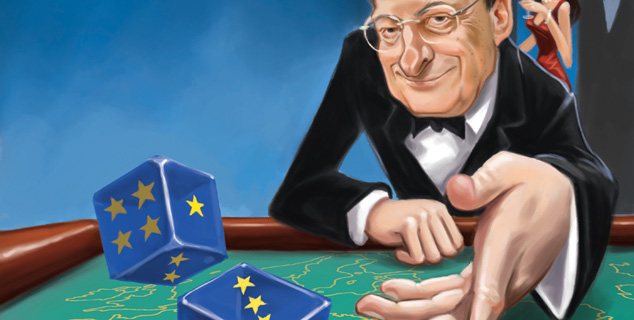
It’s Mario Draghi’s big day.
Today’s the day that the European Central Bank boss tips his hand.
He’s going to tell us all exactly how much quantitative easing (QE) he’s planning to pump into the eurozone.
So is Mario holding a royal flush? Or nothing better than a pair of threes?
What has QE ever done for us?
Let’s have a quick recap here.
When a central bank does the type of QE we’ve all become familiar with, it prints money to buy assets – usually government bonds.
How does this help anyone? Experts still argue over this. But it does two main things. Firstly, it lowers interest rates – it becomes cheaper for governments to borrow money. That should make it cheaper for everyone else to borrow too.
Secondly – and more importantly – it pumps a whole load of money into the market that wasn’t there before. If the central bank prints a billion euros and uses them to buy bonds from a commercial bank, for example, then there’s a billion new euros in the system.
That money has to go somewhere. It might not get loaned out to small businesses or anything useful. But it will find its way into asset markets. Even if the initial recipient of the billion euros just uses it to buy more ‘safe’ government bonds, the former holders of those bonds need to invest somewhere, and it’ll gradually make its way to riskier assets.
So here’s what QE does: it drives up asset prices; it keeps interest rates low for anyone who can access credit; and it tends to weaken the printed currency.
This does not help the ‘real’ economy right away if a) banks are too broken to lend and b) businesses cannot see any good reason to invest for the future. But it might help export-oriented businesses. And, all else being equal, a weaker currency is also inflationary – a benefit at a time when central banks are panicking about deflation.
So, approve of it or not, as an investor, QE is very significant. It’s not the only factor in your investment decisions, but it’s definitely one you have to be aware of and to take into account. If a whole chunk of printed money is about to hit a market, then that matters.
And that’s why all eyes are on the ECB today.
Decision time for Mario Draghi
The ECB and Germany have been waging a tug of war over eurozone monetary policy for at least a few years now.
To cut a long, much-repeated story short: the most troubled countries in the eurozone (Greece is the prime example) need a weak currency and a reliable buyer of last resort for their government’s debt. That’s why the ECB would like to do QE.
Germany is worried that if the ECB makes life ‘easy’ for the most heavily-indebted countries, then they won’t change their ways. Germany is also philosophically opposed to the idea of QE, even though, as a huge exporter, it already benefits greatly from the weak euro.
The fear is that without some sort of help, the weakest countries will leave the eurozone out of desperation. Or they’ll default on their debts and be forced out somehow. Again, Greece is the main focus of this fear, but it’s not the only one.
Back in 2011, following the last fractious Greek election, Mario Draghi said he could and would do “whatever it takes” to keep the eurozone together. Since then, he’s hinted at doing QE many times. But he’s yet to act.
But now, with another Greek election this weekend, we’re at the crunch point. The eurozone is in deflation – prices are falling, which central banks want to avoid at all costs. (I know that might sound odd, but let’s just agree to go down that particular economic rabbit hole another time – or you can read this piece from Merryn.)
Basically, if it’s not now, it’s never.
What to watch out for
A leaked report from the ECB yesterday suggested that they’re discussing printing €50bn a month for the next two years. That’d be over a trillion euros in total.
The general market reaction to that is that it’s probably ‘enough’, as it were. But we won’t know until Mario stands up at 1:30 this afternoon (UK time).
There are all sorts of potential variations on the theme. My inbox is full of scenarios and analysts pontificating about exactly who buys the bonds, which bonds they buy, what concessions are made and to whom.
But the basic point is this: Mario Draghi has to show today that he really has the power to do ‘whatever it takes’. If he doesn’t, expect markets to panic as fear of Europe turning into Japan takes hold. (My colleague Tim Price is worried that this is what’ll happen, and it’s certainly a possibility.)
Now, I have to say, I reckon Draghi will do enough to satisfy today. He’s not spent all this time building up to it to disappoint at the last moment. And I expect that – despite scepticism about the effectiveness of QE – it will also give eurozone stocks a boost in general.
Whatever happens, we’ll have our analysis of the decision on the site later this afternoon.
By the way, if all this talk of QE leaves you cold, you’ll be reassured to know that there is still room in this world for stock-picking based on cool, logical analysis, rather than second-guessing central banks’ decisions.
Next Thursday, at 10am, our publisher is releasing a presentation about ‘invisible dividends’ – one of the most successful investment strategies I’ve seen in at least the past five years. Get your name down for a first look, and we’ll send it to you the moment it goes live.
As I said, as strategies go, it beats hanging around waiting for Mario…
• This article is taken from our free daily investment email, Money Morning. Sign up to Money Morning here.